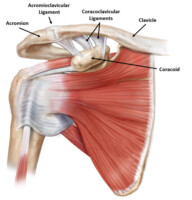An Overview of the AC Joint
The acromioclavicular joint, also known as the AC joint, is located where the clavicle (collarbone) meets the highest point of the acromion (shoulder blade). The shoulder AC joint is small and has a limited range of motion, unlike the shoulder joint. The AC joint is a critical structure within the shoulder since it is the main connection between the arm and the axial skeleton. Dr. Peter Millett, orthopedic shoulder specialist, is well-trained and highly experienced at treating orthopedic injuries and sports injuries associated with the acromioclavicular joint.
AC Joint Function
The AC joint is classified as a synovial joint. Located where the collarbone meets the shoulder blade, the shoulder AC joint allows the arm to raise above the head. It also allows the transmission of forces from the upper arm to the rest of the skeleton. The joint itself does not have its own musculature, so movement is initiated elsewhere. For instance, when the arm is raised or rotated, the AC joint moves to accommodate the action.
AC Joint Anatomy
The acromioclavicular joint’s articular surfaces are lined with fibrocartilage, much like those of the sternoclavicular joint. The cavity of the AC joint is partially divided by an articular disc that is classified as a wedge of fibrocartilage suspended from the capsule’s upper portion.
The shoulder AC joint capsule is composed of a loose fibrous layer which encloses the two articular surfaces. As a synovial joint, the joint capsule is lined by a synovial membrane that releases synovial fluid into the joint cavity.
The acromioclavicular joint is stabilized by three ligaments and two sets of muscles. The acromioclavicular ligament runs horizontally from the shoulder blade to the collarbone. The two coracoclavicular ligaments connect the coracoid process, portion of the scapula, to the collarbone. The two sets of muscles responsible for assisting with the support of the AC joint include the trapezius muscle and deltoid muscle.
Injuries related to the AC joint are fairly common and often result from a hard fall or other trauma. Some examples of these injuries include:
Dr. Millett will perform a thorough physical examination to assess a patient’s shoulder AC joint injury, and then will discuss appropriate treatments that are available for patients from Vail, Aspen and the surrounding Denver, Colorado communities.
For additional resources on the AC joint, please contact the orthopedic practice of Dr. Peter Millett.

